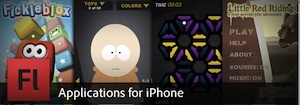 When Adobe announced the latest version of its Flash technology, a bunch of writers (including me) jumped on the fact that Flash 10.1 would eventually work on most major smartphones, except Apple’s iPhone. Looks like we spoke too soon. Sort of.
When Adobe announced the latest version of its Flash technology, a bunch of writers (including me) jumped on the fact that Flash 10.1 would eventually work on most major smartphones, except Apple’s iPhone. Looks like we spoke too soon. Sort of.
At its MAX conference in Los Angeles today, Adobe announced that after more than a year of speculation, Flash (which powers 75 percent of web video, 70 percent of web games, and plenty of other apps and media, according to Adobe) is finally coming to the iPhone. Specifically, Adobe is conducting a private beta test of a feature that will allow Flash application developers to export their apps to the iPhone. Previously, if you built a cool Flash game to run on the web and you wanted it to work on the iPhone, you’d have to write the app again, with new code. Now you can just build the app and the Flash Creative Suite can create a new version that’s downloadable to iPhones from Apple’s App Store.
However, this is still very different from the earlier announcements, which focused on getting Flash content to work in mobile browsers on Android, Palm Pre, BlackBerry, Symbian, and Windows Mobile devices. When it comes to making all the Flash content on the web, such as YouTube videos, viewable on the iPhone’s Safari browser, Adobe says that’s “something we continue to work on,” which is what the company has been saying for a while now. Even when Adobe’s Adrian Ludwig describes the new iPhone export feature in this demo video (the link also includes sample iPhone apps), he sounds kind of resigned:
The difference, of course, is that in those environments [smartphones that support Flash 10.1] you’d be playing [the Flash game] inside the browser. In [the iPhone], it’s not a browser-based application. On the iPhone, we don’t have a browser plug-in. Flash Player 10.1 isn’t available, and you can’t browse to this application and just start using it. So what developers have to do is go inside of FlashPro and export that project to a native application for the iPhone.
Adobe says it will release a public test version of the iPhone export feature by the end of the year.
